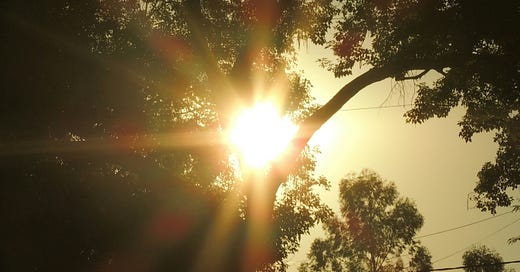catching fire is a story about light: artificial and authentic, leading you in the right direction or leading you away
ecocriticism, light and air in the second hunger games novel
Thank you so much to my paid subscribers who make everything I write here possible. That’s doubly true for big translation and commentary projects like Sir Gawain and the Green Knight, which take a lot of work and will all be posted for free. If you’d like to read more of my writing and support my work, you can become a paid subscriber for £4 per month and get an extra essay per week. Coming up soon we have the rest of this series on ecology in The Hunger Games. If you would like to support me but aren’t able to become a regular paid subscriber, I also have a ko-fi tip jar here.
The book is called Catching Fire. There are probably no prizes available for pointing out it’s a book with a lot of fire in it. Anyone who has read the book or seen the movie has seen fire ‘catching’ at a lot of important moments — Katniss as the girl on fire leading to an explosion that brings the arena down around her. I couldn’t, with a straight face, tell you I’m a very serious literary critic and my complex ecocritical take on the novel is that fire actually matters in this book.
So when I started my ‘what does the environment do in the Hunger Games’ series reread to follow up my first essay on soil in the first novel (read it, it’s good), I was hoping I’d find some new, profound, never-before-seen ecological theme. But I couldn’t get my mind off the way the book talks about light. I knew about the fire of the revolution, the girl on fire’s fire that spreads to the districts and engulfs the Capitol, but I was surprised to find how many delicate and subtly varying angles on light, natural light, artificial light, warming light, cold light, leading light, misleading light, existed here.
I saw the first novel as a book about playing a game of manipulating and transforming landscapes — the arena of the seventy fourth games created a carnivalesque space in which Seneca Crane’s technological terraforming and Katniss’ woodsman skills competed for dominance. The final moves of that game were between an act of creating horrific mutated wolves and an act of identifying edible berries, where the berry identification won.
Middle books in trilogies are always odd beasts. They’re often my favourites — I’m always only one glass of wine away from explaining why The Two Towers is the best Lord of the Rings movie. Middle books in trilogies often have the job of taking the first book’s simple premise, stretching and broadening it, and opening up new ways to head out sideways. We have a clear starting point in a neatly-constructed opening book. We’re winding towards a clear finishing point. But the middle book doesn’t have to be concerned with either of those, it just plumbs deeper and deeper into whatever depths it wants. Its beginning doesn’t have to be a beginning and its end doesn’t have to be an end.
So Catching Fire is about fire in a neat way that leads on to the conclusion of Mockingjay — the girl on fire starts a revolution that will eventually win — but it doesn’t constrain itself to one type of light building. Catching Fire discusses light from all different angles. We see artificial light and natural light nested inside each other and it can be hard to sure which one we’re looking at.
In The Hunger Games, Katniss and the Capitol competed to control the land, and in this book, they compete to control the light.
Over and over again, the book tells us there’s such a thing as engaging honestly or dishonestly with light. The Capitol uses artificial light to light up the world and our heroes find ways to take warmth and emotional meaning from it anyway. The book’s most virtuous characters are able to have an honest relationship with light even when it’s not real. The Capitol can light up a photoshoot and put an artificial sun up in an arena, but Katniss and the rebels are able to be aggressively authentic in the face of artificial light. What’s the Capitol meant to do when someone keeps being aggressively honest and truthful under their constructed, artificial light? The same thing they did when someone insisted on being a real naturalist in their constructed, artificial landscape in the first novel — they lose.
Cinna’s firy mockingjay wedding dress is introduced after a lot passages of description of stage lighting. I think this is a bit of context that gets ignored a lot in discussion of the ‘girl on fire’ imagery. She’s a girl on fire surrounded by hot, bright stage lights. So she’s not just on fire, and she’s not just bright, she’s actively eclipsing lights that were meant to be the hottest and brightest things in the room.



